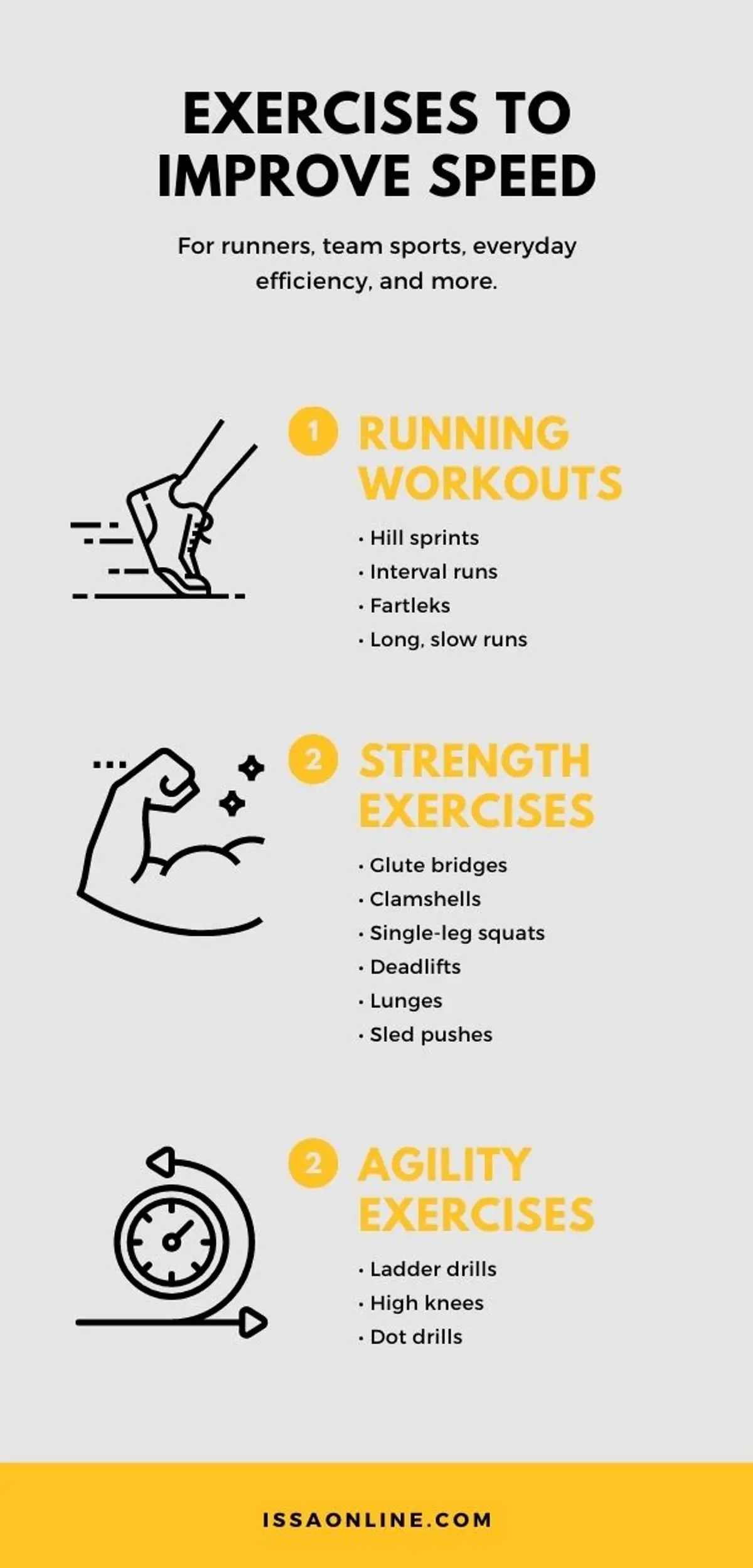Strength training for runners enhances performance and reduces injury risk. A balanced plan includes exercises targeting core, leg, and upper body muscles.
Runners often focus solely on cardiovascular endurance, yet overlooking strength training can be a critical error. Integrating a strength training routine into a running plan is pivotal for improving speed, power, and efficiency. By targeting core stability, leg strength, and upper body fitness, runners can achieve better form and maintain it as fatigue sets in during long runs.
This balanced approach not only bolsters performance but also plays a crucial role in injury prevention, as stronger muscles support joints and absorb the repetitive impact of running. Implementing a diverse regimen that includes squats, deadlifts, planks, and push-ups can condition the body for the rigors of running, ensuring athletes hit their stride with enhanced capability and resilience.

Credit: www.issaonline.com
The Synergy Between Running And Strength Training
The synergy between running and strength training often goes unrecognized. Yet, combining these disciplines propels athletes toward peak performance. Runners gain not only speed and endurance but also a robust structure capable of withstanding rigorous demands. Let’s dive into how integrated workouts and a focus on muscular balance can revolutionize your running plan.
Boosting Performance With Complementary Workouts
Strength training complements running by enhancing muscle efficiency and power. With targeted exercises, runners can:
- Improve speed and acceleration
- Boost endurance for longer distances
- Amp up overall performance
By merging plyometrics with weightlifting, runners develop explosive power. This translates to quicker pace gains and more dynamic strides.
| Exercise Type | Benefits |
|---|---|
| Plyometrics | Increased explosive power |
| Weightlifting | Improved muscle strength |
Reducing Injury Risk Through Muscular Balance
Strength training builds balance and stability in muscles. This prevents overuse injuries common in runners. Engaging in a diverse range of exercises:
- Strengthens support muscles
- Promotes joint health
- Ensures overall muscular balance
By focusing on core, hip, and leg muscles, runners maintain better posture and form. This reduces the stress on any single muscle group. As a result, athletes enjoy a lower risk of sidelining injuries.

Credit: www.puregym.com
Key Muscle Groups For Runners To Target
Runners need to focus on specific muscle groups for better performance. Strength training is vital. It helps prevent injuries. It also boosts speed and endurance. Knowing which muscles to target can make a huge difference. Find out the key muscle groups that support your running journey.
Core Stability For Sustained Efficiency
The core is central for runner’s stability and posture. A strong core lets runners maintain form even when tired. This helps with efficiency. A good plan includes:
- Planks: Builds endurance in both the abs and back.
- Bridge: Strengthens the glutes and lower back.
- Superman: Enhances lower back and supports the spine.
These exercises contribute to a tougher, more resilient core. Running longer distances becomes easier. You keep good form throughout.
Leg Strength For Improved Endurance And Power
Leg muscles are fundamental for runners. Strong legs mean better endurance and more power for each stride. To build leg strength, focus on:
| Exercise | Muscles Targeted |
|---|---|
| Squats | Quads, hamstrings, and glutes. |
| Lunges | Glutes and hamstrings. |
| Deadlifts | Back, glutes, and hamstrings. |
These exercises support powerful leg muscles. This leads to longer strides. Your endurance sees a significant boost. Build these muscles for a better running experience.
Designing Your Strength Training Routine
Designing Your Strength Training Routine plays a crucial role for runners aiming to enhance performance and prevent injuries.
This plan blends strength exercises with running schedules to build endurance and power.
Incorporating Strength Workouts Into A Running Schedule
Balance is key. Plan strength training on non-consecutive days to give muscles time to recover.
- Post-run is ideal for light strength work
- Separate hard run days from intense strength sessions
Ideal Frequency And Intensity For Runners
Aim for 2-3 strength sessions per week.
| Level | Frequency | Intensity |
|---|---|---|
| Beginner | 2 times/week | Low (Body weight) |
| Intermediate | 2-3 times/week | Moderate (Dumbbells) |
| Advanced | 3 times/week | High (Barbells) |
Remember, rest days are critical for muscle repair and growth.

Credit: www.issaonline.com
Strength Exercises Tailored For Runners
Runners gain many benefits from strength training. Strong muscles boost speed and endurance. A strength plan also cuts injury risk. This plan focuses on runner-specific training.
Bodyweight Movements for Accessible TrainingBodyweight Movements For Accessible Training
Bodyweight exercises are easy to start. They need no gym or gear. They can be done anywhere, anytime.
Key movements focus on the lower body and core. This helps stability during runs.
- Squats: They target legs and glutes for power.
- Lunges: They improve balance and coordination.
- Planks: They strengthen the core for better posture.
- Push-ups: They enhance upper body strength to maintain form.
Resistance Training For Enhanced Muscle Activation
Adding resistance grows muscles more than bodyweight alone. Runners use resistance training for extra muscle activation.
| Exercise | Target Area | Benefit |
|---|---|---|
| Dumbbell Squats | Legs, Glutes | Increased leg power |
| Deadlifts | Back, Hamstrings | Enhanced running posture |
| Leg Press | Quads, Calves | Stronger push-off |
Small weights are best for starters. Increase weight slowly. This prevents injury and helps progress steadily.
Monitoring Progress And Adaptations
As runners integrate strength training into their routines, it’s crucial to monitor progress and adaptations. Tracking improvements not only motivates but also ensures that the training is effective, leading to better running performance and reduced injury risk. Adaptations to the plan, based on evidence of progress or the need for greater challenge, keep the training beneficial and engaging.
Tracking Strength Gains Alongside Running Improvements
Consistent tracking is key to seeing the link between strength gains and running performance. Keeping a training log can be incredibly useful. Here’s what to include:
- Weight amounts lifted in each session
- Repetitions and sets completed for every exercise
- Changes in running pace, distance, and perceived effort
- Body measurements and weight, if relevant
Create a simple table to visualize progress over weeks or months. This reveals trends and highlights areas needing attention.
| Week | Squat (lbs) | Deadlift (lbs) | Run Pace (min/mile) | Comments |
|---|---|---|---|---|
| 1 | 100 | 120 | 8:00 | Felt strong |
| 2 | 105 | 125 | 7:50 | Better endurance |
Adjusting The Plan For Continued Progress
When strength and running targets are hit, it’s time to adjust the plan. This means:
- Increase weight levels gradually
- Change exercises to challenge different muscles
- Introduce new running workouts to boost speed and endurance
Make small changes every few weeks. This prevents plateaus and keeps training exciting. Listen to your body and update your training log to reflect what’s new. Use this information to fuel your next steps and stay on the path to success.
Nutrition And Recovery In A Runner’s Strength Plan
Nutrition and recovery form the backbone of any runner’s strength training plan. Balancing nourishment and rest not only fuels the grueling dual demands of running and strength exercises but also accelerates muscle repair and growth. Without the right food and recovery strategies, progress stalls, and injury risks skyrocket. Let’s dive into how to power through strength training with robust nutrition and optimize recovery to keep your training consistent and effective.
Fueling For The Dual Demands Of Running And Lifting
To meet the energy needs of both endurance and resistance training, runners must pay close attention to their diet. An effective plan combines carbohydrates for running energy, protein for muscle repair, and fats for overall health. Let’s break down the key nutritional components:
- Carbohydrates: They are the primary energy source during long runs and intense lifts.
- Protein: Essential for muscle repair post-workout.
- Fats: Necessary for prolonged energy and nutrient absorption.
Runners should plan their meals around workout schedules, ensuring they consume complex carbs and protein within a 30-minute window post-exercise for optimal muscle recovery.
Recovery Strategies To Maximize Training Benefits
Proper recovery is non-negotiable for any strength training runner. Here’s how to ensure the body bounces back stronger:
- Active Recovery: Engage in low-intensity activities like walking or yoga.
- Sleep: Aim for 7-9 hours each night for adequate muscle repair.
- Nutrition: Consume a balanced mix of proteins and carbs post-run.
Incorporating foam rolling and stretching routines can alleviate muscle tension. Hydration plays a crucial role as well, helping to flush out toxins and deliver nutrients to cells.
| Time of Day | Meal Type | Key Nutrients |
|---|---|---|
| Morning | Breakfast | Proteins, Carbs, Healthy Fats |
| Post-Workout | Snack | Proteins, Simple Carbs |
| Evening | Dinner | Proteins, Complex Carbs, Veggies |
Frequently Asked Questions On Strength Training For Runners Plan
How Many Times A Week Should Runners Strength Train?
Runners should aim to strength train 2 to 3 times a week. This regimen helps prevent injuries and improves performance.
How Should Runners Do Strength Training?
Runners should incorporate full-body workouts twice weekly, focusing on core strength, leg power, and glute activation. Opt for exercises like squats, deadlifts, and lunges, while maintaining correct form to prevent injuries. Balance intensity and rest to aid recovery.
How Do I Schedule My Strength Training And Running?
Start by alternating days of strength training and running. Schedule rest days to allow for recovery. Prioritize strength exercises for leg days post-run to enhance muscle adaptation. Keep high-intensity interval training on separate days from long runs. Adjust intensity based on your body’s response.
Should Runners Lift Heavy Or Light?
Runners should include both heavy and light lifting in their training, focusing on building strength and muscle endurance. Balance is key for optimal performance.
Why Is Strength Training Important For Runners?
Regular strength training enhances running efficiency and reduces injury risk by improving muscle balance, joint stability, and overall athleticism.
What Exercises Should Runners Focus On?
Runners should focus on compound movements like squats, lunges, deadlifts, and core exercises for comprehensive strength development.
Conclusion
Embracing the principles of strength training can significantly enhance a runner’s performance. It bolsters endurance, speed, and overall health. Implement this structured plan to witness a transformative impact on your running journey. Forge resilience and smash your personal bests; let strength pave your path to running prowess.
















